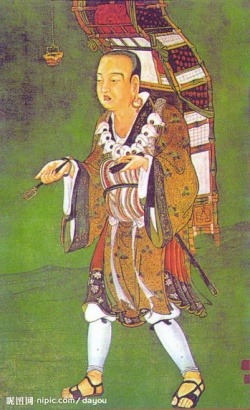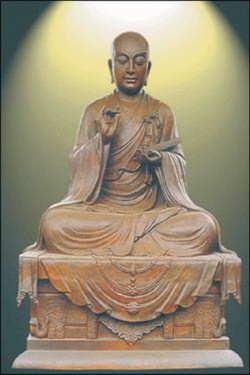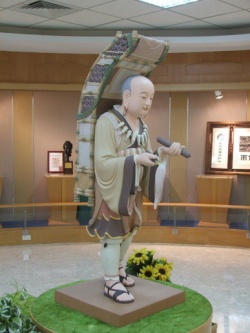Xuanzang and the ‘Warehouse-Consciousness’ concept in China by Silvia Romanelli
Xuanzang was born in the year 600 or maybe 602 into a scholars' family in Kaifeng, now Henan province. At the age of 12 he entered a monastery in Luoyang and in 622, after having received his complete ordination as a Buddhist monk in Chengdu, he moved to the Chinese capital Chang'an (modern Xi'an). There he continued his studies, discovered the diversity of Buddhist schools and developed a particular interest in the Yogacara school. Confused by the great differences in the interpretation of some Buddhist concepts, he decided to face a long and dangerous journey towards the west countries in search of answers about the doctrine. In spite of the emperor's refusal to give him the permission to move away from China, Xuanzang decided to leave secretly in 627, or maybe 629. In those days, there were two ways to travel to or from the west: by sea, sailing from the coasts of south China, passing through Sumatra and Malaysia towards the gulf of Bengal; or by land, starting from Dunhuang, a Chinese multicultural city and a main trade centre on the Silk Road. Xuanzang took the land route.
Travelling at night and hiding during the day, he passed the last Chinese outposts in Gansu region. Then he travelled to the north of the Taklamakan desert and via the regions of Bactria, Gandhara and Kashmir, he reached the famous monastic city of Nalanda, in the north-east of India. There he stopped for a year and studied under the guide of an important Indian Yogacara master. After leaving Nalanda, he travelled along all the perimeter of India finding his way back to China and arrived in Chang'an in 645 with a caravan of 20 horses, carrying on their backs all the relics, the icons and the 657 Buddhist texts that he had collected during his 16 years travel in the western countries. Despite his clandestine departure 16 years before, at his return Xuanzang was received by the emperor Taizong in person and decorated with honours. Thanks to the imperial support, he could spend the rest of his life translating the Buddhist texts he had taken back to China, albeit with the help of a large team of translators and monks. He died in Chang'an in 664. Xuanzang's translation work dealt mostly with the texts of the Yogacara Buddhist school. Indeed, Xuanzang is considered the “Master Patriarch” of one of the Yogacara-oriented schools in China: the Faxiang School. Before this one, two other Yogacara-oriented schools had already developed in China during the 6th century: the Dilun School and the Shelun School. These three schools differed in the interpretation of some basic Yogacara concepts, in particular the one of “Warehouse-Consciousness”. With his works, Xuanzang took part in the Warehouse-Consciousness' controversy and gave his own interpretation of this concept.
The origins of the Yogacara school date back to three Indian masters called Maitreyanatha, Asanga and Vasubandhu, who probably lived in the 4th century in the Kashmir area. The earliest sutra containing Yogacara concepts is the Samdhinirmocana Sutra, most likely written at the beginning of the 3rd century.
The main statement of the Yogacara School is that reality, as we perceive it, is nothing but a production of our mind and the contents of one's experience are mere representations of consciousness. It's like when we see images in a mirror and the images are considered as something different from the person who sees them, but actually the perceived images are nothing but the perceiving mind. This does not necessarily mean that reality doesn't exist at all and our life is like a dream, but only that the way we see reality -and not reality in itself- is a false construction of our mind.
The information our sensory systems give us about reality consists of a lot of perceptions and experience, which are really existent but are misconceived by our mind, that interprets them in relation to the Ego. Without realizing it, we consider our Ego as a subject facing all the surrounding world, that is taken as an object. Consequently we tend to desire more and more experience that gives pleasure to the Ego and to reject the unpleasant experience. Because of the belief in reality of self and objects, we develop continuous aversion and attachment towards things and our desires can never be fully satisfied. Here is the root of passions and human infinite discontent, the feeling that what we have is never enough. Due to this insatiable desire, we have to leave different lives through continuous rebirths. This is what Buddhism calls the “law of karmic retribution”. Every action involving desire leaves behind it a karmic seed, that in its turn will be the seed of a future experience in our life, a kind of retribution for our actions. An action caused by desire will produce other desires.
According to the Yogacara, the karmic seeds produced by actions are stored in the Warehouse-Consciousness -one of the forms or functions that our consciousness can take- until they produce another piece of experience. The Warehouse-Consciousness is central to the karma system because, on one side it receives the seeds from our everyday actions and on the other side, containing these seeds, it is the source of future experience. It's the continuous flow of experience and seeds that constitutes the cycle of rebirths, called “samsara”. Nevertheless, this negative flow can be reversed by purifying the seeds.
Through a spiritual and gradual path, we can achieve an internal transformation of all our mental activity and eliminate the subject/object pattern from our mind. This will cause the gradual destruction of the bad seeds and the development of our pure seeds, that can lead us to liberation from samsara, that is enlightenment. This is the achievement of wisdom, that finally is nothing but a purification of our way of thinking.
The Yogacara texts were introduced to China more or less in the same centuries as the texts about “Buddha Nature”. This expression means that there is in everybody a seed of the nature of the Buddha that we could become. It's like a treasure hidden in the earth: it's always been there, but only once discovered, it can be brought to a full realization. The Chinese Buddhist authors between the 5th and the 7th centuries showed a strong tendency to superimpose or oppose the concept of Buddha Nature to that of Warehouse Consciousness. Very often the first was considered as the good part in human nature, the one that can bring to enlightenment, whereas the second was seen as the deluded part, the one that keeps us tied up to samsara. As a consequence, enlightenment tended to be regarded as a sudden discovery of an already-existent and static Buddhic nature and not as a long and gradual process of spiritual growth.
On the contrary, Xuanzang tried to untie the concept of Warehouse-Consciousness from any links to the Buddha Nature. More faithful to the Indian Yogacara masters, he described the Warehouse-Consciousness not as an unchangeable good or bad part in the human being, but as an uninterrupted flow of experience and karmic seeds that carries us continuously from one rebirth to the other. So the question arises of how we could disentangle from the chain of rebirths. The answer, says Xuanzang, is in our There are in fact not only impure seeds, but also pure ones. The impure seeds are those linked to our basic ignorance about reality, that is the illusion that an Ego does exist, which involves some sorts of intent or desire for our actions, even for the more noble ones. The pure seeds, on the contrary, don't involve any thinking of a subject or actions driven by desire.
To achieve enlightenment, we should develop our pure seeds and destroy the impure ones, that means learning not to think in terms of self and objects and not to be attached to these ideas. But what if we don't have pure seeds at all?
According to Xuanzang, not everybody has pure seeds: some people have them, so they are able to reach enlightenment; some people have only some, so they can achieve only a lower kind of enlightenment, and some people do not have pure seeds at all, so they are fated not to reach enlightenment. Nevertheless the ones who have pure seeds are not already enlightened, if they want to achieve liberation they have to cultivate and gradually develop their pure seeds, through a hard path of spiritual growth. Because of this theory, Xuanzang's school received a lot of criticism in the Chinese Buddhism's environment of the 7th century, in which the idea of Buddha Nature was growing more and more in importance.
Xuanzang's gradualist and selective theory couldn't obtain a spread success at his times; but it definitely has the merit for reminding us that the path for self-improvement is always gradual and not so easy as discovering a kind of divine nature that is already in us and on which we can rely on to achieve enlightenment.


